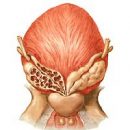You have long felt - something is wrong with you. Without any causes began to break the lower back, on the bottom of the abdomen spilled out. After the next attack you went to the gynecologist. «You have a small cyst in the ovary, - the doctor stated. - If it does not grow, cure». «And if it will be?» - You were frightened.
Content

Each third patient who appeals to the gynecologist, an increase in ovaries is observed during inspection. It may be inflammation, and a tumor - benign or malignant. Unfortunately, the usual inspection does not allow to judge what «Missed» in the ovary, because this body is quite complicated. In total tumors there are already 10 groups, not counting the nuances.
Kista is a benign ovarian formation filled with liquid. If the cyst is not treated, it can happen really unpleasant: cysts can be inflamed, caught up, break, and sometimes reborn into malignant tumors. 77-80% of women who launched the cyst, detect a tumor.
Where does the ovarian cyst begins?
Once a month in the ovary of each woman, a tiny bag-capsule filled with liquid is formed, — follicle. When an egg ripen inside it, the follicle shell is broken, the release of the egg outward. That is, ovulation. If ovulation does not occur for any reason, the follicle sometimes continues to grow, forming the cyst.
Another physiological variety of cysts can develop in a small cavity formed in the ovary after displacing the eggs. These cavities are filled with blood vessels and new cells forming a yellow body that produces a hormone progesterone. As a rule, the yellow body exists within two weeks, and then, if pregnancy does not occur, eat, forming a tiny scar. But if the surface of the ovary is bleeding and blood gets into the yellow body, a cyst can form, filled with blood. It usually disappears through 1–2 months.
In any case, it is better not to suffer to guesses, but to apply a visit to the gynecologist. It is not worth pulling with an operation to remove a cyst, because there is a small risk of cancer, and malignant neoplasms can grow very quickly and easily go to neighboring fabrics and organs. Fortunately, it happens quite rarely: ovarian cysts are malignant only at 10–12% of cases.
 Ovarian cysts can find a woman at any age, but after 40 years the probability of this increases noticeably. The trouble is that the resulting cyst may not serve for a long time «Signs of life», And the woman does not even suspect her existence until the doctor finds the cyst during the usual preventive inspection or with the help of ultrasound. There are patients who are not worried about! The only thing that they cannot become pregnant because of the irregular work of the ovaries. To do this, it is important to pass at a gynecologist at least once a year.
Ovarian cysts can find a woman at any age, but after 40 years the probability of this increases noticeably. The trouble is that the resulting cyst may not serve for a long time «Signs of life», And the woman does not even suspect her existence until the doctor finds the cyst during the usual preventive inspection or with the help of ultrasound. There are patients who are not worried about! The only thing that they cannot become pregnant because of the irregular work of the ovaries. To do this, it is important to pass at a gynecologist at least once a year.
Only when cystic tumors increase so that they start putting on the bladder, intestines or abdominal wall, you «Notice». Very rarely, such a cyst may cause sudden severe pains, the delay in the next menstruation or, on the contrary, the incessant discharge.
But far from each cyan you can please the surgical table. Some cysts develop due to hormonal disorders, others - «laid down» from birth, but develop only if something is not in order, as if responding to another disease. For example, on the background of inflammation of the organs of a small pelvis. What complaints may be? It depends on the magnitude and location of the cyst.
Most «popular» Symptom - a stupid, still pain at the bottom of the abdomen, in the lower back, groin. And do not take pain relief painkillers! It is better not to pull and immediately see a doctor. Otherwise, acute pain, nausea and vomiting will soon appear, and this is a sign of complications, for example, twisted cysts or its rupture.
Cyst «keeps» for the ovary with the help of a leg through which «Food», that is supplied with blood. If the leg is twisted, you will constantly hurt the bottom of the abdomen. At the same time you will tear, sick, flowing blood pressure, the pulse will be frequent, leather pale. Even faint can easily fall.
Abdominal muscles will be reflexively tense, you can be frightened or stopped constipation, it is difficult to urinate, the temperature rises a little. Some women complain about very painful menstruation and nevertheless do not go to the doctor, they say: «I always had it». And this is just a faithful sign of cysts!
Most often, the cyst is detected using an ultrasound: it is possible to find out its type, dimensions and probability of rebirth into malignant.
Functional cyst arises due to hormonal failure. With proper treatment (usually oral contraceptives are used for this) these cysts are absorbed by themselves. If they do not disappear after 3 months, you need to do the operation. The rest of the cysts need to be removed, because they can turn into a malignant tumor.
When twist the cysts and in the case of other complications, such as its break, also make operation. When the cyst is removed, you can get rid of the child normally and give birth to a child. In addition to functional cyst, there are tumors — Kistomy. Where they would neither take, you need to beat the alarm while these formations have not switched to malignant. In this case, avoid the operation fails.
 If the cyst arose on the soil of the inflammatory process, it is treated according to the same scheme as the usual inflammation of the appendages - physiotherapy, anti-inflammatory drugs, biostimulants, immunomodulators, vitamins, hormonal drugs, sometimes antibiotics. If nothing helps, and cyst continues to grow, his Majesty Scalpel comes into business.
If the cyst arose on the soil of the inflammatory process, it is treated according to the same scheme as the usual inflammation of the appendages - physiotherapy, anti-inflammatory drugs, biostimulants, immunomodulators, vitamins, hormonal drugs, sometimes antibiotics. If nothing helps, and cyst continues to grow, his Majesty Scalpel comes into business.
Benign brushes are removed using a laparoscopic operation. True, if we are talking about tumor education, and it is difficult to figure out the malignant or not, with the help of other diagnostic methods it is difficult, then urgent analysis (the so-called histological examination) of cells taken from tumors are carried out right during operation. If the cystom is benign, only the tumor tissue is removed, keeping a woman ovary and the opportunity to become a mother.
Laparoscopic operation allows you to remove the cyst with the minimum injury and the maximum preservation of healthy ovarian fabrics. After such an operation, there is no ugly scar and it takes less time to restore. Malignant tumor has to be removed using a regular open operation so as not to «Disconnect» Sick cells on other organs and fabrics. In any case, it is better not to sit and not be afraid, but immediately run to the gynecologist. And do not worry, you will definitely hear from him that «To live will be»!









